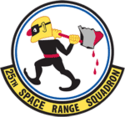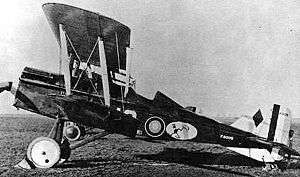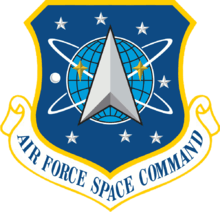25th Space Range Squadron
| 25th Space Range Squadron | |
|---|---|
|
Royal Aircraft Factory S.E.5, 25th Aero Squadron, Gengault Aerodrome (Toul), France, November 1918 | |
| Active |
1917–46 1988–95 2004–present |
| Country |
|
| Branch |
|
| Role | Space range operations |
| Size | Squadron |
| Garrison/HQ | Schriever Air Force Base, Colorado |
| Nickname(s) | "Executioners" |
| Mascot(s) | Hatchet Man |
| Engagements |
|
| Decorations |
|
| Insignia | |
| 25th Space Range Squadron Squadron |
 |
The 25th Space Range Squadron (25 SRS) is a non-flying squadron of the United States Air Force. It is a geographically separated unit assigned to the Nevada Test and Training Range, Air Force Warfare Center, Air Combat Command, Schriever Air Force Base, Colorado. The 25 SRS operates the Space Test and Training Range (STTR).[1]
The 25 SRS is one of the oldest units in the United States Air Force, first being organized as the 25th Aero Squadron on 13 June 1917 at Kelly Field, Texas. The squadron deployed to France and fought on the Western Front during World War I as a pursuit squadron. The unit was demobilized after the war in 1919.[2]
Re-organized in 1921 as part of the permanent United States Army Air Service, the squadron served in the Panama Canal Zone during the Inter-War period, then as part of 20th Air Force in the Pacific Theater of Operations (PTO) of World War II flying B-29 Superfortress bombers. During the Cold War, it was part of Strategic Air Command, equipped with B-47 Stratojet medium bombers until its inactivation in 1964.[3]
Mission
The 25th Space Range Squadron is responsible for the operation of the Space Test and Training Range, a capability that allows units to exercise space capabilities in a safe, secure and realistic environment while eliminating the risk of unintended collateral effects.
The 25 SRS owns the advanced concepts environment, which simulates a target, weapon system and environment for training and rapid reaction prototype development. The 25 SRS has also deployed equipment and personnel to support theater operations.[4]
History
World War I
Established as the 20th Aero Squadron in June 1917; later re-designated the 25th Aero Squadron after the United States' entry into World War I. Deployed to Europe, first to England, then to the Western Front in France in late October 1918. Assigned to the 4th Pursuit Group, 2d Army Air Service, Toul Sector, but without any airplanes. The squadron finally received some British Royal Aircraft Factory S.E.5s, mostly only armed with the single fuselage-mounted Vickers machine gun, and flew one mission on 10 November 1918 the day before the war ended. It was demobilized after the 1918 armistice.
Panama service

The squadron was reactivated as the 25th Aero Squadron on 1 October 1921 at France Field the Panama Canal Zone, as part of the 6th Composite Group.[5] It flew various biplane bombers to defend the Panama Canal. During the 1920s and early 1930s, It participated in various goodwill missions in Latin America, including the Goodwill flights to El Salvador and Nicaragua, 13–19 May 1935, to Guatemala, 8–11 February 1938, and to El Salvador, 19–22 April 1938. The squadron also flew mercy mission to Chile following the devastating 1939 Chillán earthquake, 28 January-13 February 1939.
The 25th Bombardment Squadron became the 25th Bombardment Squadron (Medium) on 6 December 1939 and then, on 20 November 1940, the 25th Bombardment Squadron (Heavy).[5] Equipped with the Douglas B-18 Bolo the squadron had opportunity to put its new, long-legged aircraft to the test in October 1939, when two Peruvian flyers, en route from the United States to Lima, Peru on a long-distance flight, were reported missing between the Canal Zone and Peru. Although eventually found to have made an emergency forced landing in Ecuador, three B-18s of the squadron conducted extensive searches of the area along the 80th meridian some 250 miles to sea. The aircraft carried enough fuel for a flight of 11 hours duration, a capability which would place them in good stead in the Command in the years to come.
By 25 August 1941, with its pre-war strength at but five B-18s, the Squadron was re-equipped with B-17E Flying Fortresses. After the United States entered World War II, the Squadron had deployed to Salinas, Ecuador and the Galapagos Islands (shuttling patrols hack and forth) with four of the B-17Es, flying antisubmarine patrols over the Pacific approaches to the Panama Canal. These aircraft being joined by a B-18 by February. The main body of the Squadron left Salinas by 15 February and returned to Howard Field in early 1943, although a detachment was still in Ecuador as late as 30 June.
Assignment to the 6th Bombardment Group ended on 12 May 1943, when the Squadron was transferred to the 40th Bombardment Group and, the following month, the main body of the Squadron, which had been at Howard Field briefly between 16 May 1943 and 13 June, ended its 21 years of service in the Canal Zone, when it was reassigned to the United States.
B-29 Superfortress era

Assigned to Pratt Army Airfield, Kansas in July 1943, being re-manned with new personnel. Received prototype and early production-model B-29 Superfortress very heavy bombers. Trained under Second Air Force for an extended period due to Boeing technicians making modifications of B-29 aircraft. Deployed to the new XX Bomber Command as part of the 58th Bombardment Wing in the China-Burma-India Theater, flying to bases in India via South Atlantic Transport route; across central Africa, Arabia to Karachi. Additional modifications of B-29s were necessary in India to accommodate very high ground temperatures (115 °F).
From airfields in eastern India, engaged in very long range bombardment raids on Japan. The squadron participated in the first American Air Force attack on the Japanese Home Islands since the 1942 Doolittle raid on 15/16 June 1944, attacking the Imperial Iron and Steel Works at Yawata on Kyushu by using its forward staging base at Hsinching Airfield (A-1), China, for refueling.[6] Performed a total of nine missions to Japan, also engaged in very long range attacks against enemy targets in Thailand, Manchuria, Borneo, Formosa, Burma, Malaya, Japanese-occupied China, Singapore, Saigon and Cam Rahn Bay, French Indochina. Also engaged in aerial mining of Japanese-occupied seaports in Thailand Malaya and French Indochina.[6]
Advance of American forces in the Central Pacific though the Northern Mariana Islands made new airfields available within the effective bombing range of Japan. Moved to West Field on Tinian in April 1945, becoming part of the new XXI Bomber Command. From the Marianas, engaged in very long range strategic attacks on Japan, its first mission being on 5 May 1945 against the Hiro Naval Aircraft Factory in Kure. Air attacks over Japan were initially high-altitude daylight bombing missions against industrial, transportation and military targets, largely ineffective due to high upper level winds dispersing bombs over a wide area. By July, began low-level large area night incendiary raids on urban areas, and dropped mines in Japanese shipping lanes. Continued aerial assaults until the Japanese Capitulation in August 1945, final combat mission taking place on 9/10 August attacking the Hikari Naval Arsenal.[6]
After V-J Day, the squadron dropped food and supplies to Allied prisoners in Japan, Korea, and Formosa, and took part in show-of-force missions. Demobilized on Tinian in 1946, aircraft being returned to the United States for storage. Inactivated as a paper unit in October.
Strategic Air Command and Air Combat Command
Reactivated in 1953 under Strategic Air Command (SAC), receiving then second-line B-29s for training and organization. Replaced the propeller-driven B-29s with new B-47E Stratojet swept-wing medium bombers in 1954, capable of flying at high subsonic speeds and primarily designed for penetrating the airspace of the Soviet Union. In the late 1950s, the B-47 was considered to be reaching obsolescence, and was being phased out of SAC's strategic arsenal. Began sending aircraft to other B-47 wings as replacements in early 1964, being one of the last SAC squadrons equipped with the Stratojet. Inactivated in September when the last B-47 aircraft was retired.
Reactivated in 1988 as a SAC training squadron. From 1988 to 1992, supervised SAC B-52H Stratofortress bomber crew training, and from 1992 to 1995, Air Combat Command (ACC) B-52H Stratofortress and then B-1 Lancer bomber crew training program at Ellsworth AFB, South Dakota.
Lineage
- 25th Aero Squadron
- Organized as the 20th Aero Squadron On 13 June 1917
- Redesignated 25th Aero Squadron on 22 June 1917
- Demobilized on 17 June 1919
- Reconstituted and consolidated with the 25th Bombardment Squadron as the 25th Bombardment Squadron on 8 April 1924
- 25th Space Range Squadron
- Authorized as the 25th Squadron (Bombardment) on 30 August 1921
- Organized on 1 October 1921
- Redesignated 25th Bombardment Squadron on 25 January 1923
- Consolidated with the 25th Aero Squadron on 8 April 1924
- Redesignated 25th Bombardment Squadron (Medium) on 6 December 1939
- Redesignated 25th Bombardment Squadron (Heavy) on 20 November 1940
- Redesignated 25th Bombardment Squadron, Very Heavy on 20 November 1943
- Inactivated on 1 October 1946.
- Redesignated: 25th Bombardment Squadron, Medium on 9 May 1952
- Activated on 28 May 1952
- Inactivated on 1 September 1964
- Redesignated 25th Strategic Training Squadron on 21 June 1988 and activated
- Redesignated 25th Flying Tactics Training Squadron on 1 September 1991
- Redesignated 25th Training Squadron on 15 June 1993
- Inactivated on 21 September 1995
- Redesignated 25th Space Control Tactics Squadron on 1 July 2004 and activated
- Redesignated: 25th Space Range Squadron on 11 November 2007
Assignments
|
|
Stations
|
|
Aircraft
|
|
See also
- List of American Aero Squadrons
- Hilbert Bair
- List of B-29 units of the United States Air Force
- List of B-47 units of the United States Air Force
References
![]() This article incorporates public domain material from the Air Force Historical Research Agency website http://www.afhra.af.mil/.
This article incorporates public domain material from the Air Force Historical Research Agency website http://www.afhra.af.mil/.
- ↑ 25 Space Range Squadron (AFSPC)
- ↑ Series "E", Volume 9, History of the 25–27th Aero Squadrons. Gorrell's History of the American Expeditionary Forces Air Service, 1917–1919, National Archives, Washington, D.C.
- ↑ Maurer, Maurer, ed. (1982) [1969]. Combat Squadrons of the Air Force, World War II (PDF) (reprint ed.). Washington, DC: Office of Air Force History. ISBN 0-405-12194-6. LCCN 70605402. OCLC 72556.
- ↑ 25 SRS Capabilities Handout, dated 2008
- 1 2 Conaway, William. "25th Bombardment Squadron (Heavy)". VI Bomber Command in Defense of the Panama Canal 1941–45.
- 1 2 3 Mann, Robert A. (2009), The B-29 Superfortress: A Comprehensive Registry of the Planes and Their Missions, McFarland, ISBN 0-7864-4458-4
- ↑ Conaway, William. "6th Bombardment Group (Heavy)". VI Bomber Command in Defense of the Panama Canal 1941–45.
- ↑ Conaway, William. "40th Bombardment Group (Heavy)". VI Bomber Command in Defense of the Panama Canal 1941–45.
- Maurer, Maurer, ed. (1982) [1969]. Combat Squadrons of the Air Force, World War II (PDF) (reprint ed.). Washington, DC: Office of Air Force History. ISBN 0-405-12194-6. LCCN 70605402. OCLC 72556.
- Conaway, William. "VI Bomber Command in Defense of the Panama Canal 1941–45". Planes and Pilots of World War Two.
- Hagedorn, Dan (1995). Alae supra canalem = Wings over the canal: the Sixth Air Force and the Antilles Air Command. Paducah, KY: Turner Pub. Co. ISBN 978-1-56311-153-2
- Mayborn, Mitch (1971). The Boeing B-29 Superfortress (Aircraft in Profile 101). Leatherhead, UK: Profile Publications (reprint). OCLC 36547156




.png)
.jpg)